🚨 The Challenge: Your pricing moves fast, but your billing tool can’t keep up
You’ve tried the standard SaaS billing software. They work until things get complicated.
Now you’re dealing with:
🧩 Custom pricing and contract variations
🔁 Frequent plan changes and mid-cycle edits
📈 Hybrid models with recurring, usage-based, or milestone billing
💸 Flexible terms like net-30, deferred, or installments
And this isn’t just you.
According to Deloitte, 94% of B2B SaaS pricing leaders changed pricing or packaging in the past year. Nearly 40% do it every quarter.
Most billing systems weren’t built for that kind of change.
👇 That’s why we’re highlighting five subscription billing software options that go beyond just invoicing. They help SaaS teams grow faster, collect upfront, and stay in control. One of the standout options is Ratio Boost — built to turn billing flexibility into a revenue driver.
But before we dive into the list, let’s look at what you should be evaluating in these tools as a buyer.
Choosing Subscription Billing Software That Helps You Grow, Not Just Bill (A Buyer’s Guide)
Choosing subscription billing software isn’t a product decision. It’s a business decision. The right platform shapes how you sell, how soon you get paid, and how cleanly you scale.
Nearly half of enterprise software purchases now take over four months to approve — because smart buyers don’t chase flashy features. They take time to evaluate what problems a tool actually solves.
To help you move faster without cutting corners, we’ve compiled some key considerations that matter. Here are some:
1. Native Support for Custom and Evolving Pricing
Your billing platform should handle usage-based, milestone-driven, and hybrid pricing models without needing engineering workarounds. Flexibility should be built in, not bolted on.
2. Sales-Led Billing That Matches How You Close Deals
Look for systems that let you reflect custom terms, mid-cycle changes, and co-termed add-ons in real time, directly from your CRM. Billing should follow sales, not slow it down.
3. Built-In Cash Flow Control with Flexible Payment Terms
The platform should help you offer net-30, deferred, or installment plans without waiting to get paid. Embedded financing options let you close faster while collecting upfront.
4. Finance Automation Without Losing Flexibility
Billing should auto-generate accurate invoices, handle proration, sync with your accounting stack, and adapt to edge cases, while keeping audit trails clean and revenue forecasts real.
5. Real-Time Visibility for GTM and Finance Teams
You should be able to monitor deal-level billing logic, track revenue schedules, and understand cash flow impact without waiting for spreadsheets or month-end close.
6. Scalable Architecture That Doesn’t Require Rebuilds
The platform should scale with you from PLG to sales-led to multi-year enterprise deals, without logic breaking, workflows fragmenting, or needing to re-implement in 18 months.
These are the exact criteria we used to evaluate current top subscription billing software options for b2b SaaS businesses. And we found five options that check all the right boxes and go well beyond just billing. Let’s check them out.
Five Best Subscription Billing Software Options That Go Beyond Just Billing
We didn’t include the usual suspects. These five subscription billing software options stood out because they go well beyond the basics. Whether it’s embedded financing, usage-based pricing, AR automation, or revenue intelligence — each of them solves for billing and the real-world challenges around it.
For example, one platform helps you offer flexible payment terms like net-30 or installments — and you still collect your full contract value upfront. Another integrates billing with sales workflows, so your team can move from quote to cash without friction.
Here’s the full list:
- Ratio Boost
- Maxio
- Chargebee + Chargebee Receivables
- Zenskar
- Orb
Here you can also check this quick comparison table below to see who they are best for and their current market position.
👇 Now, let’s break down what each one does best and know if it’s the right fit for your team.
🥇 1. Ratio Boost
Ratio Boost isn’t another billing tool. It’s a proposal, billing, and financing platform designed for b2b SaaS and other subscription businesses that want to offer flexible terms to buyers and still collect full revenue upfront.
By embedding BNPL directly into your quote-to-cash process, Ratio Boost lets sales teams say yes to any customer payment terms without sacrificing cash flow. Sellers get paid by Ratio for full contract value upfront. This move transfers credit risk off your balance sheet, reduces discounts, and closes deals faster — all while automating billing and collections in the background.
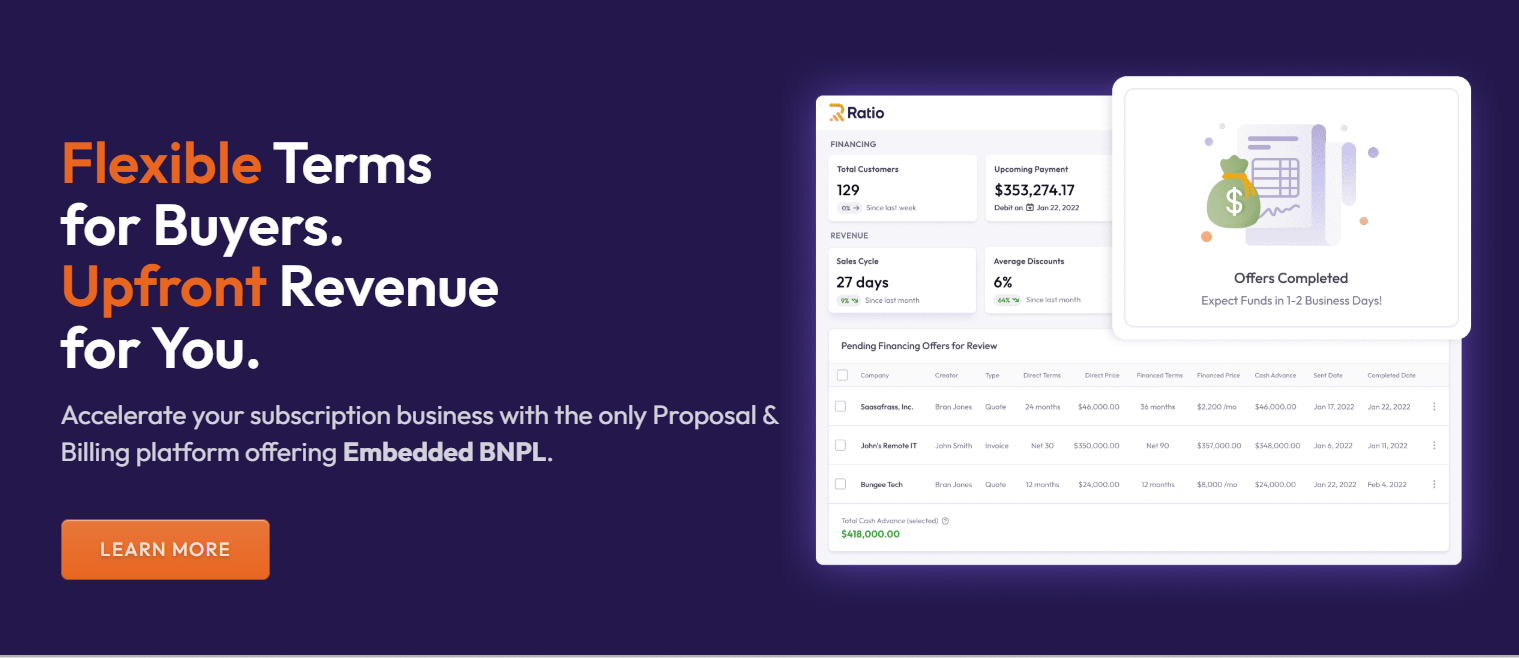
🎯 Best For
- Company Type: B2B SaaS, subscription-based hardware, and services businesses
- Sales Motion: Sales-led teams dealing with contract negotiation, custom pricing, or payment flexibility
⚙️ Core Capabilities (How It Goes Beyond Just Billing)
Ratio Boost redefines billing by embedding it directly into the quote-to-cash journey — and then layering financing on top. Instead of just automating invoices, it gives you tools to sell faster, structure smarter deals, and collect full revenue on Day 1, regardless of how or when your buyer pays.
Here’s how it goes beyond just billing:
Here’s how it goes beyond just billing:
- Embedded BNPL: You can offer traditional terms (e.g., monthly, quarterly) or deferred payments while collecting the full TCV upfront
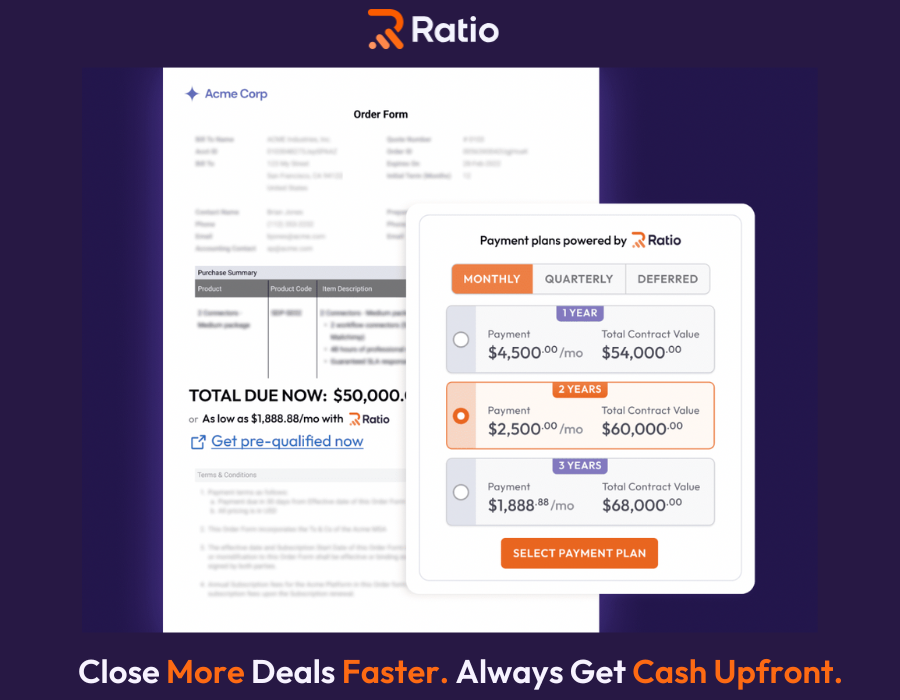
- AI-Powered Decisioning: Pricing, approvals, and credit risk modeling handled instantly using real-time buyer data
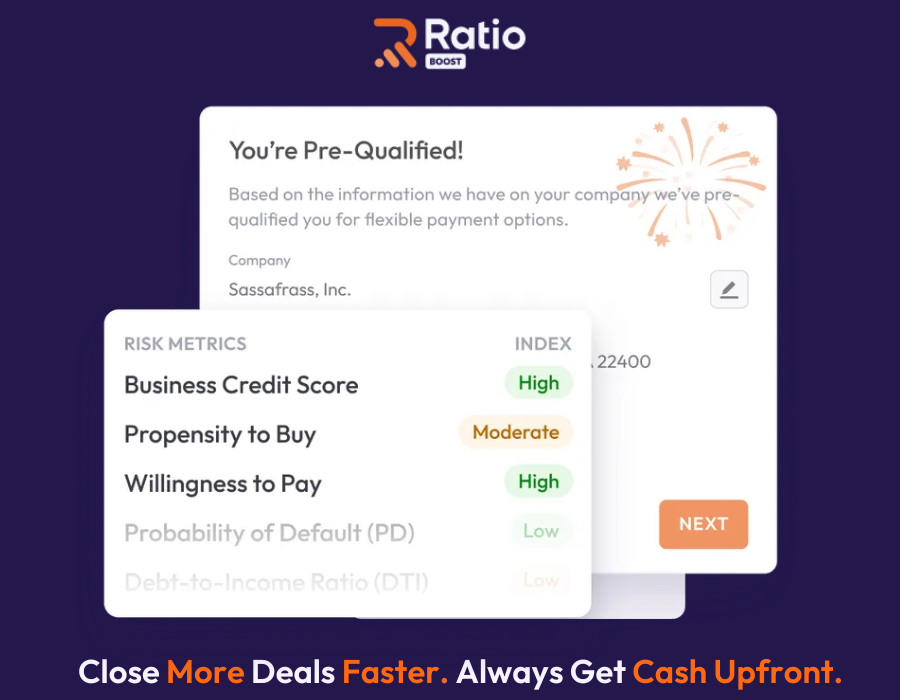
- Customizable Proposals: Tailored offers, terms, and schedules embedded directly into your CRM (e.g. Salesforce)
- Dynamic Underwriting: Instant credit decisions (<1 second) with transparency and buyer risk scoring

- Self-Close Experience: Deals can close 24/7 through an interactive buyer checkout flow
- Automated Billing & Collections: Ratio handles all invoicing, reconciliation, and follow-ups — no internal AR ops needed
- Risk Mitigation: Ratio funds the deal and holds the buyer risk — you stay asset-light and capital efficient
- Integrated Sales Workflow: Plugs into your current systems of offers the full suite across quoting, CPQ, payments, and collections — no tool sprawl
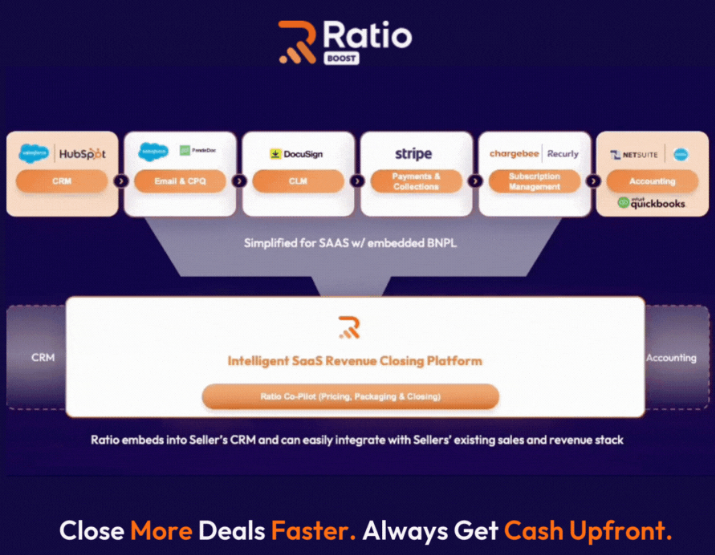
This isn’t billing-as-usual, it’s billing as a revenue growth driver.
⚠️ Limitations
While Ratio Boost offers powerful billing and financing capabilities, it’s not a one-size-fits-all solution. Here's where it may not be the right fit:
- Not ideal for product-led growth (PLG) or fully self-serve SaaS models where billing needs to run entirely without sales involvement
- Requires AE-led sales to unlock full quote-to-cash automation — less valuable for companies without structured sales workflows or with solely self-service checkouts
- Financing approvals depend on buyer qualification — very small or early-stage buyers with weak credit profiles may see limited payment plan options
💬 Client Feedback
One founder’s experience with Ratio Boost:

💰 Pricing
Ratio Boost doesn’t follow flat-rate or per-seat pricing. It operates on a performance-based model tied to deal volume and financing usage. Pricing is tailored based on:
- Your deal size and frequency
- Whether you use embedded financing or just billing
- The level of platform integration (CRM, CPQ, etc.)
There’s no large upfront cost — instead, Ratio earns when you win deals and collect cash.
🖥️ Demo/Trial Availability
You can request a personalized demo of Ratio Boost to see how it fits into your sales and finance stack. The team typically offers:
- Live walkthroughs of CPQ + billing + BNPL flow
- Use-case-based customization (SaaS, hardware, services)
- ROI-focused consultation tied to your current sales cycle
👉 Visit here to request a demo and explore whether Ratio can help your team close faster and collect smarter.
🥈2. Maxio
Maxio is more than just a subscription billing platform. It’s a financial operations suite purpose-built for B2B SaaS companies managing complex billing, usage models, and rev rec. Born from the merger of SaaSOptics and Chargify, Maxio brings together finance-grade billing, subscription analytics, and revenue recognition in a single, scalable platform.
It helps SaaS teams go beyond invoice automation by giving them the tools to streamline pricing ops, track performance, and handle usage-based and hybrid contracts — without resorting to spreadsheet chaos or custom dev work.
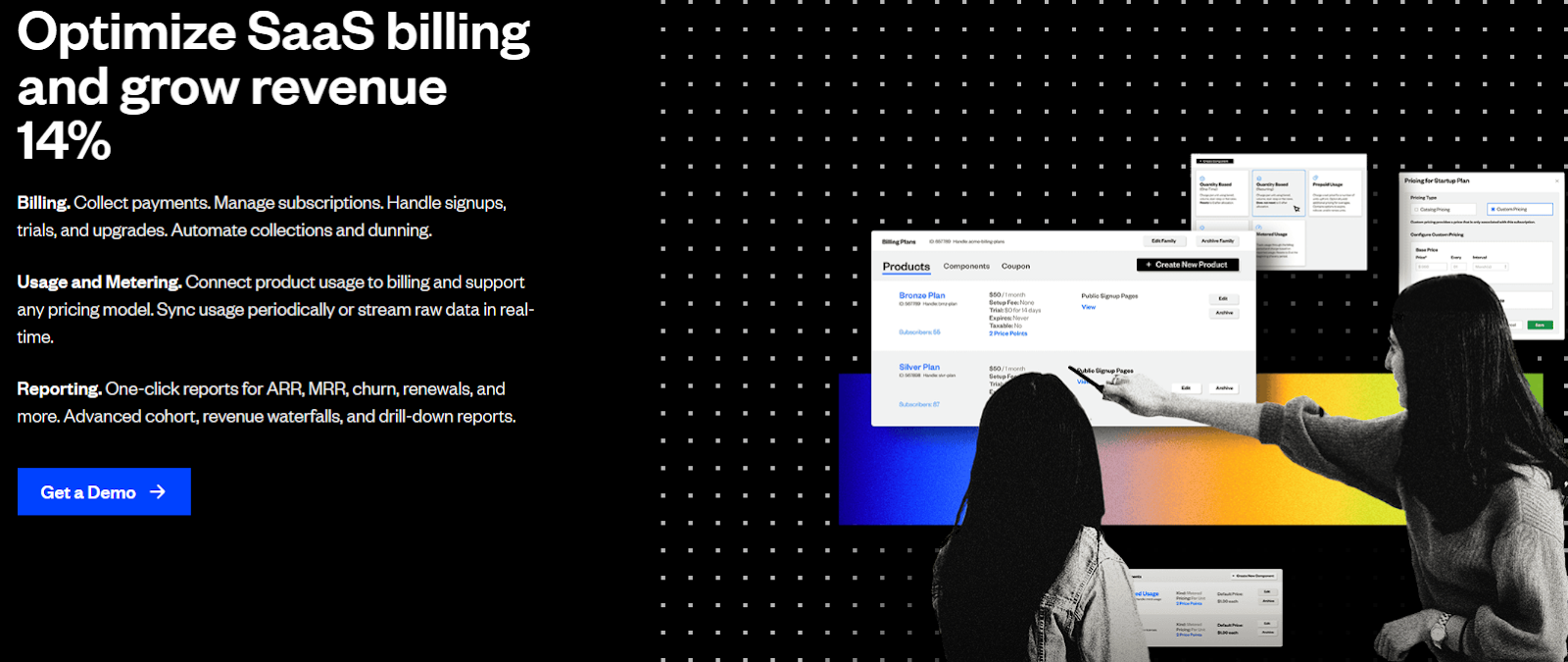
🎯 Best For
- Company Type: Mid-market to growth-stage B2B SaaS companies with multi-product catalogs and growing finance ops
- Sales Motion: Sales-assisted or hybrid motions with complex billing logic, co-term contracts, or revenue forecasting needs
⚙️ Core Capabilities (How It Goes Beyond Just Billing)
Maxio doesn’t just send recurring invoices — it offers full-stack billing, analytics, and revenue infrastructure. Here’s how it stands out:
- Hybrid Pricing Models: Supports per-unit, tiered, metered, flat-rate, volume-based, and stair-step pricing
- Offer Management Engine: Build and customize subscription offers dynamically — without bloating your product catalog
- Usage-Based Billing: Sync real-time product usage data directly to invoices with flexible aggregation
- Automated Invoicing & Dunning: Scale recurring billing with custom workflows, retries, and past-due logic
- Revenue Recognition: Automate rev rec based on contracts, usage, or delivery milestones — audit-ready
- Self-Serve Subscription Portal: Let customers manage their own billing details, upgrades, and renewals
- Cohort-Level Reporting & SaaS Metrics: Real-time dashboards for ARR, MRR, churn, renewals, and revenue waterfalls
- Prepaid Billing + Multi-Currency Support: Adaptable for global SaaS use cases and complex cash collection
This is ideal for finance teams that want precision and control over every dollar.
⚠️ Limitations
Maxio is powerful, but not for everyone:
- Overkill for Early-Stage Startups: If you’re a small team with basic billing needs, the complexity may outweigh the benefit
- Longer Implementation Time: Setup for usage-based billing or rev rec requires thoughtful onboarding
- Not Native to CRM Workflows: It’s more finance-led than sales-integrated, so CPQ and quoting may require third-party tools
💬 Client Feedback

💰 Pricing
Maxio offers custom pricing based on your:
- Billing volume and invoice complexity
- Modules needed (e.g., rev rec, analytics, usage-based billing)
- Level of integrations and onboarding support
There’s no public pricing page, but expect tiered plans with add-ons for advanced features.
👉 Best to request a quote for your use case.
🖥️ Demo/Trial Availability
You can book a live product demo directly from the website. Demos typically include:
- Real-time walkthroughs of billing, subscription, and rev rec workflows
- Use-case mapping to your pricing model
- Guided Q&A with solution engineers
🥉3. Chargebee Billing + Receivables
Most billing tools automate invoices. Chargebee automates growth. From dynamic pricing experiments to end-to-end revenue automation, it helps SaaS companies manage the entire subscription lifecycle. At the same time, Chargebee Receivables reduces churn and unlocks cash stuck in failed payments.
Together, they create a billing + collections stack that doesn’t just send invoices — it maximizes revenue retention, speeds up collections, and supports global scale.
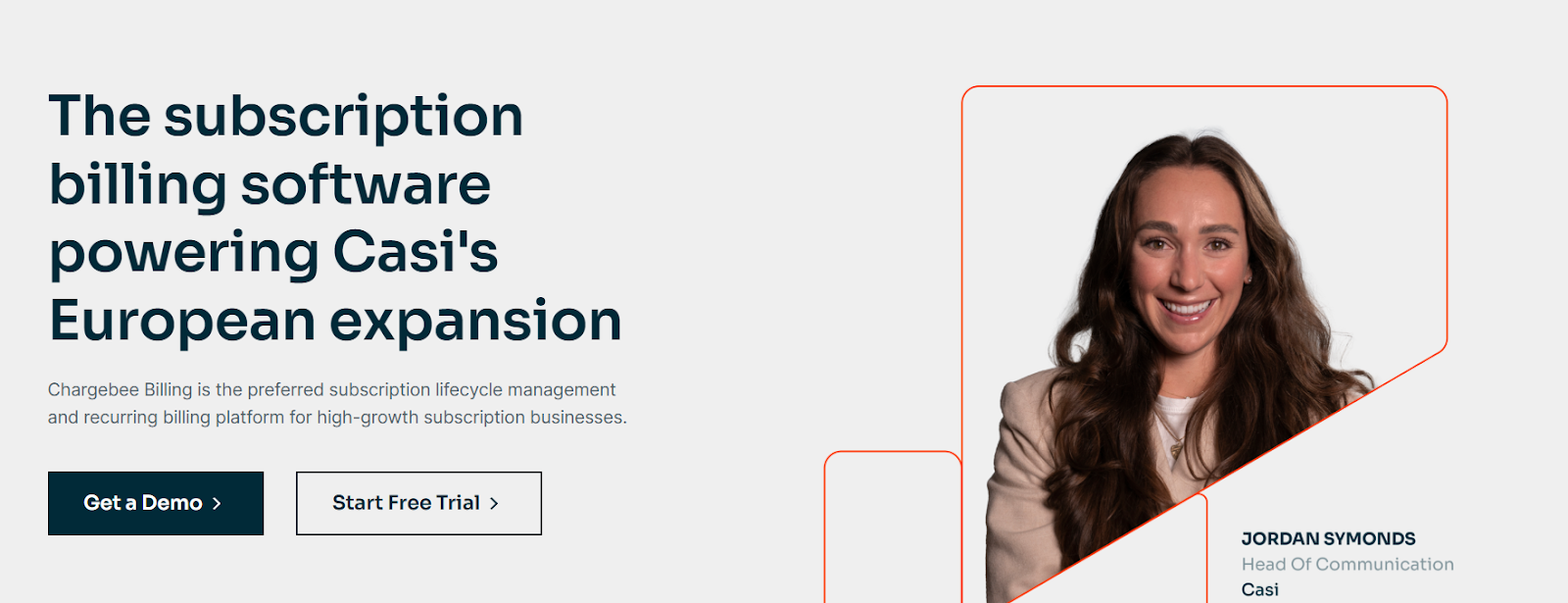
🎯 Best For
- Company Type: Mid- to late-stage SaaS businesses scaling globally
- Sales Motion: Product-led or hybrid teams looking for robust billing, AR automation, and global compliance
⚙️ Core Capabilities (How It Goes Beyond Just Billing)
Chargebee + Receivables offers more than recurring billing. It helps teams run strategic experiments, recover lost revenue, and build scalable billing operations across geographies.
Here’s how it goes beyond just billing:
- Subscription Lifecycle Automation: From trial to renewal, automate plan changes, upgrades, downgrades, and cancellations
- Revenue Intelligence: Real-time dashboards for MRR, churn, deferred revenue, and revenue forecasting
- Global Compliance Built-In: Handles global taxation (VAT, GST), currencies, and PCI-DSS
- Customizable Product Catalog: Supports 480+ billing scenarios, usage-based pricing, and rapid monetization experiments
- Chargebee Receivables: AR dashboard, automated dunning, customer segmentation, dispute management, and recovery workflows
- Self-Serve + Customer Portal: Branded portals for payment updates, plan changes, and account management
- Prebuilt Integrations: Works with CRMs, ERPs, and over 20+ payment gateways
This is billing plus AR automation, customer retention, and growth enablement — all rolled into one.
⚠️ Limitations
While Chargebee is a powerful platform, there are trade-offs:
- Complex Setup for Smaller Teams: Initial configuration can be resource-intensive without a dedicated finance ops team
- Cost Scales with Usage: As business complexity increases, so does platform cost
- Receivables Add-On: Full AR automation (collections, recovery) requires separate implementation and isn’t bundled by default
- Advanced Features = Learning Curve: More capabilities mean more onboarding and training time
💬 Client Feedback

💰 Pricing
Chargebee offers tiered pricing based on business size and billing volume:
- Launch Plan: Free up to $250K revenue
- Rise & Scale Plans: Starting at $249/month, depending on features and volume
- Receivables: Sold separately — pricing based on AR volume and feature use
Custom enterprise pricing is available for high-volume SaaS companies.
🖥️ Demo / Trial Availability
Chargebee offers:
- Live product demos for both Billing and Receivables
- Custom walkthroughs based on your business model
- Free sandbox access for testing billing flows
4. Zenskar
Designed for modern SaaS pricing, Zenskar helps you bill for anything: from dynamic usage to milestone-based contracts, tiered pricing, and everything in between.
If your pricing evolves fast or doesn't fit a flat monthly fee model, Zenskar gives your team the infrastructure to quote, bill, and scale with confidence — without breaking things in spreadsheets or engineering workarounds.
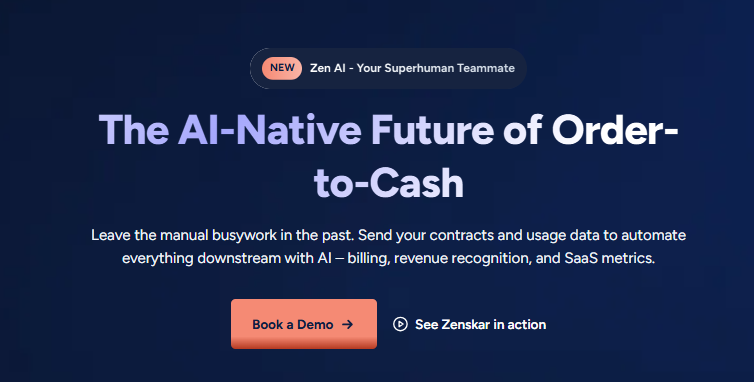
🎯 Best For
- Company Type: Growth-stage SaaS companies with complex or evolving pricing models
- Sales Motion: Sales-led or hybrid GTM teams needing flexibility across contracts and pricing
⚙️ Core Capabilities (How It Goes Beyond Just Billing)
Zenskar shines when standard billing platforms fall short — especially for companies with dynamic pricing needs or contract-specific billing rules.
Here’s how it goes beyond just billing:
- Flexible Usage & Hybrid Billing: Supports volume, tiered, milestone, event-based, or custom pricing out of the box
- No-Code Pricing Engine: Finance teams can configure and update pricing logic without developer support
- Smart Contract Handling: Automates proration, co-termination, and backdated changes with audit-ready logs
- Modular Quote-to-Cash Flow: Native quote builder, custom approvals, and CPQ-like capabilities
- Real-Time Data Syncing: Usage metering APIs and integrations with product analytics tools
- Audit-Ready Invoicing: Fully compliant with GAAP, ASC 606, and custom rules for revenue recognition
- Multi-Entity, Multi-Currency Support: For businesses expanding across geographies or business units
Zenskar helps SaaS teams stop hacking their billing — and start scaling it strategically.
⚠️ Limitations
- Still Maturing: Newer in the market, so the ecosystem and third-party integrations are more limited
- Custom Implementation: Requires more upfront implementation and configuration than plug-and-play tools
- Smaller Team Size: Limited community support and smaller partner ecosystem compared to legacy billing giants
💬 Client Feedback
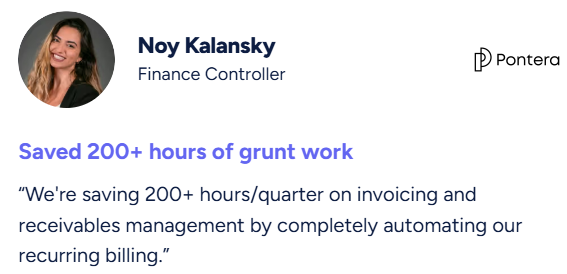
💰 Pricing
Zenskar offers custom pricing based on your billing volume, usage patterns, and features enabled.
- No published flat-rate plans
- Most suited for teams billing $1M+ in ARR with flexible pricing needs
- Typically offers volume-based discounts for scaling companies
You’ll need to connect with their team to get a tailored quote.
🖥️ Demo / Trial Availability
Zenskar offers:
- Personalized demos for finance and product teams
- Custom sandbox environments to simulate usage billing
- Proof-of-concept implementation for qualified prospects
5. Orb
Orb is purpose-built for modern usage-based SaaS billing. If your pricing depends on actual customer usage, product actions, or consumption metrics, Orb gives you the precision, scalability, and flexibility to operationalize it — without building custom logic from scratch.
It’s not just a billing engine — Orb is a usage data platform, CPQ, and revenue automation suite rolled into one. Think of it as Stripe Billing for usage-first SaaS, but smarter and made for scale.
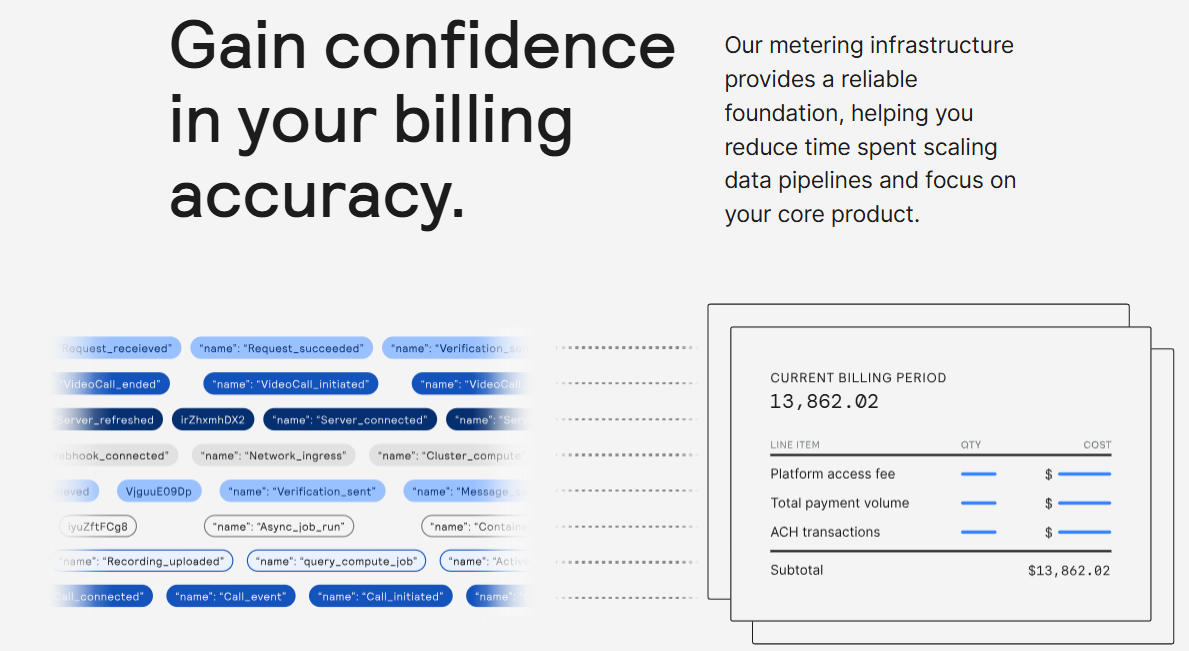
🎯 Best For
- Company Type: Product-led and usage-heavy SaaS companies (especially API-based products, infrastructure tools, and developer platforms)
- Sales Motion: Self-serve or hybrid GTM models with technical buyers and variable pricing
⚙️ Core Capabilities (How It Goes Beyond Just Billing)
Orb goes far beyond automated invoices. It solves billing at the usage data layer, then builds monetization logic and revenue operations on top.
Here’s how it goes beyond just billing:
- Real-Time Usage Metering: Stream live data directly from your product via robust APIs or batch uploads
- Custom Pricing Rules: Set up tiered, volume-based, or time-based pricing plans with dynamic formulas
- Versioned Pricing Models: Update pricing over time while maintaining audit trails and grandfathered plans
- Transparent Customer Portal: Buyers can track usage, costs, and forecasts in real-time — reducing billing disputes
- Built-in CPQ & Quoting: Create and approve dynamic offers for large accounts without duct-taping tools
- Revenue Recognition Engine: ASC 606-compliant revenue tracking based on consumption, not just invoicing
- Advanced Reporting: Cohort-based metrics, product engagement impact, forecast modeling — all in one place
⚠️ Limitations
- Dev-Heavy Setup: Requires product and engineering involvement to implement usage pipelines
- Not Ideal for Fixed Pricing: If your pricing is static or simple, Orb may be overkill
- Fewer Built-In Payment Tools: Orb focuses on metering and pricing — you’ll need to plug in your own payments and collections stack (e.g. , Stripe, Netsuite)
💬 Client Feedback
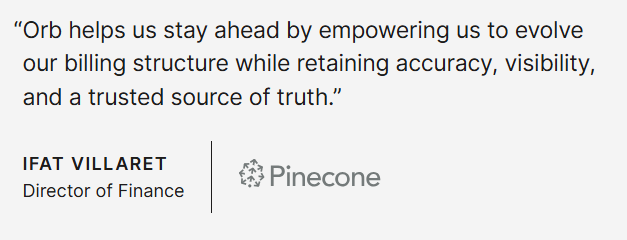
💰 Pricing
Orb offers custom pricing tiers based on:
- Monthly tracked usage events
- Features like CPQ, revenue recognition, analytics
- Support and onboarding requirements
They typically work with startups and scale-ups, billing $1M+ ARR with complex pricing logic. Pricing is volume-based and available on request.
🖥️ Demo / Trial Availability
Orb offers:
- Live demos tailored to your product architecture and GTM model
- Usage simulation environments to test pricing logic
- API documentation and dev support during the trial phase
Each platform we covered approaches subscription billing in its own way. Some focus on flexibility. Others on automation or scale.
But one platform goes further. It helps you close more deals, move faster, and collect cash upfront — without the collections headache.
Its Ratio Boost: the top choice for subscription billing software for a reason.
Let’s take a closer look to understand why.
🏆Why Ratio Boost Is the Top Pick for Subscription Billing Software That Does More Than Just Billing
Ratio isn’t just another billing tool — it’s a revenue infrastructure layer trusted by the fastest-growing SaaS companies.
Take DearDoc, for example. Before Ratio, they faced:
- 🔻 Losing deals due to upfront payment friction
- 💸 Heavy discounting to close
- 🔧 2–3 disconnected tools for billing, contracts, and collections
After implementing Ratio Boost:
✅ 35% increase in close rate
✅ 25% increase in ACV
✅ 60%+ total revenue uplift
✅ Full TCV collected upfront
✅ Fewer tools, less ops overhead, zero bad debt headaches
Listen to what the founder has to say:
But it doesn’t stop there. In June 2025, Ratio announced:
- 📈 800% YoY growth
- 🛠️ Launch of Custom Payment Terms — letting sellers structure billing around buyer cash flow (monthly, milestone, deferred, or blended)
- 🤝 Addition of Taxwell (Drake Software) as a marquee customer
Why did Taxwell choose Ratio?
Because they needed a platform that could:
- Tailor payment options to SMB buyer cash flow
- Integrate into their complex sales and finance workflows
- Unify quoting, contracting, financing, and billing — without bolting on a separate CPQ
If you’re a SaaS team looking to increase subscription bookings without delaying cash collection, Ratio Boost is the platform to try.
👉 Book a demo today and see how much more revenue you can unlock when billing actually works for sales.
Disclaimer: Information in this post is based on publicly available sources, customer testimonials, and vendor websites as of the date of publication. While we aim for accuracy, features and terms may change. We recommend connecting with each provider directly to get a demo and discuss the latest capabilities before making a decision.
❓FAQs on Subscription Billing Software (What Buyers Really Want to Know)
1. What’s the Real Cost of Switching Subscription Billing Software?
Switching isn’t just about implementation time — it’s about data migration, workflow realignment, and change management. Most teams underestimate the hidden cost of inflexible legacy systems: revenue leakage from proration bugs, quote delays, manual reconciliation, and slow collections.
The right billing platform won’t just replace an old tool — it should compress your sales cycle, reduce finance workload, and shorten your cash conversion cycle. If it doesn’t do that, the switching cost is a sunk cost.
2. How Should Subscription Billing Software Support Sales-led vs. Product-led Growth?
Product-led growth (PLG) needs self-serve, metered billing with minimal sales touch. Sales-led growth needs the opposite: flexibility for contracts, custom terms, co-terms, and billing logic that reflects how humans negotiate.
Most platforms do one or the other. Few do both well. If your motion is hybrid, your billing engine needs to bridge structured sales and usage-based automation — without creating workflow debt in RevOps or Finance.
3. How do Billing Platforms Impact Valuation During Fundraising or Acquisition?
Investors scrutinize revenue quality. Billing impacts:
- Churn reporting (Are you recognizing earned revenue or just bookings?)
- ARR predictability (Are there skipped invoices, write-offs, collections risk?)
- Cash flow profile (Are you front-loading cash or stretching net terms?)
A modern billing platform should give you auditable, GAAP-aligned data and eliminate spreadsheet gymnastics before board meetings or due diligence. One missed cohort or misaligned rev rec entry can lead to a downround or worse — a lost acquisition deal.
4. Can Subscription Billing Software Reduce Customer Churn?
Absolutely — if they reduce friction in how customers start, scale, and pay. Examples:
- Frictionless onboarding with dynamic billing start dates
- Flexible upgrade paths with co-term logic
- Customer portals that give real-time visibility into usage and cost
Retention is not just about CS — it starts with how well your billing aligns with value delivery. Poor billing UX, unexpected invoices, or lack of payment flexibility silently kill retention.
5. What does “Enterprise-Ready” Actually Mean for Billing Software?
Enterprise-ready means more than “supports multiple currencies and roles.” At minimum, you need:
- Granular permissions and audit trails
- Complex approval workflows and CPQ integration
- ASC 606 / IFRS 15-compliant revenue recognition
- Multi-entity, multi-ledger support
- Modular architecture — so you don’t have to rip and replace when you scale
If your billing tool can't model contracts the way your legal and sales teams write them, it's not enterprise-ready — no matter what the landing page says.
6. Why do Finance Leaders Push for Billing Transformation — not just Sales?
Because the downstream effects are enormous:
- Rev rec automation reduces audit exposure
- Cash flow accuracy improves forecasting
- Collections automation reduces aging AR and bad debt
- Billing fidelity aligns bookings with actual revenue
The right platform gives both Sales and Finance the same source of truth, without compromise. That shared visibility is what powers faster decisions and scalable ops.
7. How should Billing Adapt to Hybrid Pricing Models (Recurring + Usage + Services)?
This is where most billing tools break. You need a platform that can:
- Blend one-time, recurring, and metered charges in a single contract
- Reflect milestone or delivery-based triggers
- Adjust revenue schedules without breaking rev rec
Modern SaaS pricing is layered. Your billing system should model your pricing intent, not force you to model pricing around system limitations.
8. What Metrics Should you Monitor to Measure Billing Efficiency?
Here’s what expert GTM and Finance teams look at:
- Time from quote to cash (how long does it take to invoice + collect?)
- Manual intervention rate (what % of invoices or changes require ops support?)
- Discount creep (how often are discounts used to offset payment friction?)
- Billing-related churn (are payment issues driving retention problems?)
- DSO vs. CAC payback (how quickly do you recover customer acquisition cost?)
Billing isn’t a backend function. It’s a revenue lever — and your metrics should reflect that.
9. Do I Need to Involve my Engineering Team to Set up or Maintain Billing Software?
Only if you choose the wrong platform. Legacy tools often require engineering just to model custom plans, sync product usage, or run basic updates.
Modern billing platforms offer no-code pricing configuration, API-based usage ingestion, and CRM-native quoting flows. If you're still asking your devs to adjust billing logic, you're scaling the wrong way.


.png)



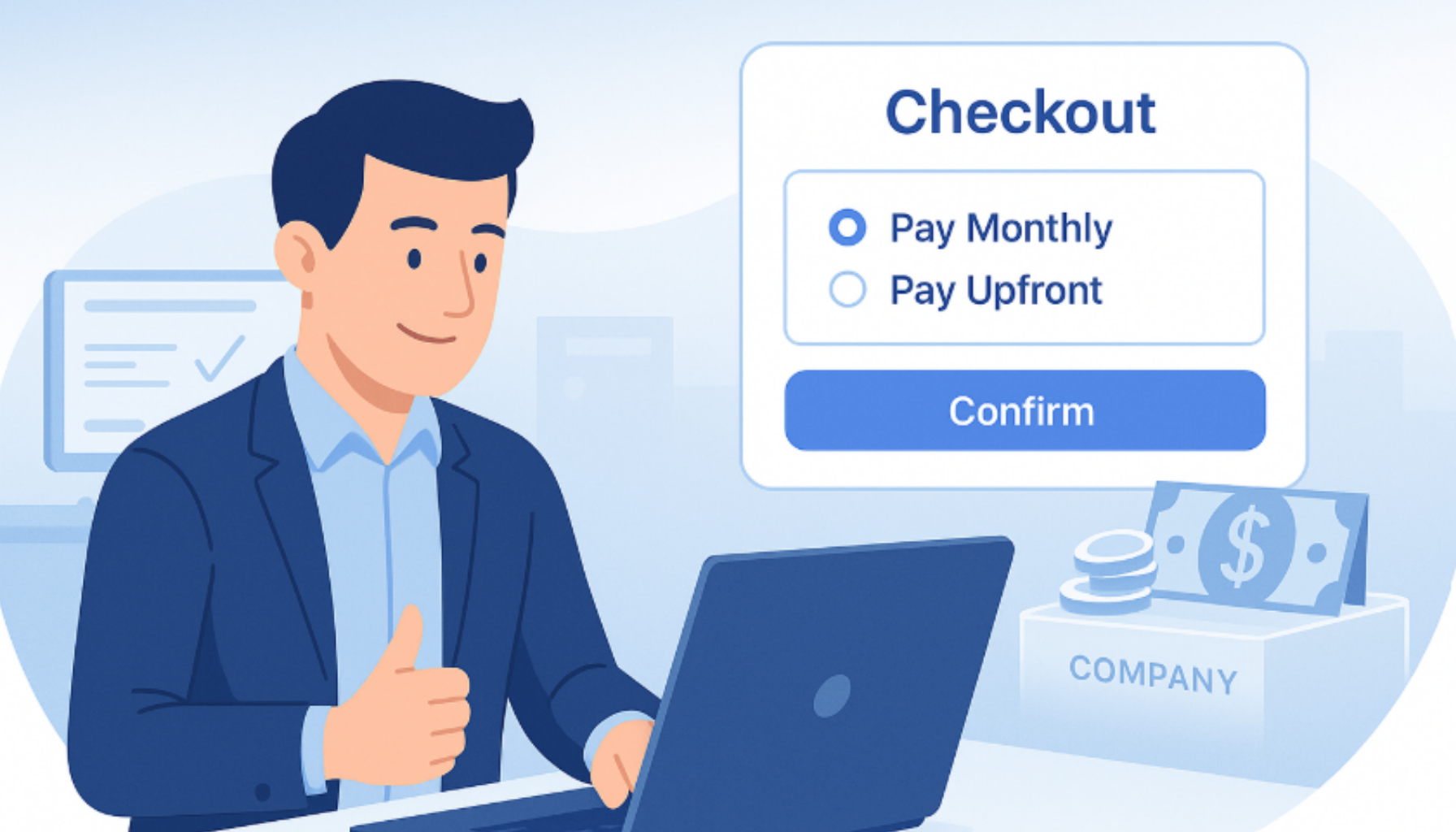
.png)


